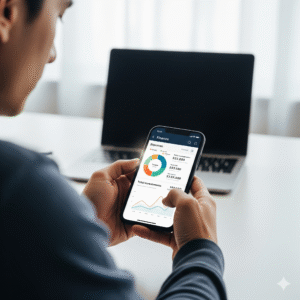Let’s be honest: the word “budget” doesn’t exactly spark joy. For most people, it brings up feelings of restriction, sacrifice, and complicated spreadsheets. It sounds like a financial diet, and nobody likes a diet. This is why most people either never start a budget or give up after just a few weeks.
But what if we reframed the idea? What if a budget wasn’t a cage, but a key? What if it wasn’t about what you can’t have, but about creating a plan to get everything you truly want?
A successful budget is not about restriction; it’s about intention. It’s a tool that empowers you to direct your money toward your most important goals, whether that’s getting out of debt, traveling the world, or building a secure future. It transforms your finances from a source of stress into a source of control.
This guide will walk you through a realistic, step-by-step process to create a monthly budget that you can actually stick with. We’ll cover everything from the crucial mindset shift to the practical tools and troubleshooting tips that will ensure your success.
Why Most Budgets Fail (And How Yours Will Be Different)

Before we build your new budget, it’s important to understand why the old ways didn’t work. Most budgets fail for a few predictable reasons:
- They are too restrictive: A budget that leaves no room for fun or a simple coffee with a friend is destined to fail. Human beings aren’t robots.
- They are unrealistic: Budgeting for $300 a month in groceries when you’ve historically spent $800 is setting yourself up for failure.
- They are a “set it and forget it” plan: A budget isn’t a crockpot. It’s a living document that needs regular check-ins and adjustments.
- They feel like a punishment: If you view your budget as a negative thing, you’ll subconsciously look for ways to rebel against it.
Your budget will be different because we’re going to build it on a foundation of realism, flexibility, and empowerment. This isn’t a financial crash diet; it’s a sustainable lifestyle change.
Step 1: The Mindset Shift – From Restriction to Empowerment
This is the most important step. Before you look at a single number, you must change your perspective.
A budget is a spending plan. That’s it. It’s you, telling your money where to go, instead of wondering where it went at the end of the month. Every dollar you assign to a category, whether it’s “Rent” or “Vacation Fund,” is a conscious choice you are making to build the life you want.
See your budget as the blueprint for your financial freedom. Want to be debt-free? Your budget is the map to get there. Want to buy a house? Your budget is the tool that will build your down payment. When you connect your daily spending habits to your biggest life goals, the budget transforms from a restriction into a roadmap.
Step 2: Know Your Numbers – Calculating Your True Monthly Income

You can’t create a plan for your money until you know exactly how much money you have to work with. This means calculating your net income, or take-home pay—the actual amount that lands in your bank account after all taxes and deductions.
- For Salaried Employees: This is simple. Look at your pay stub for the after-tax deposit amount. If you’re paid twice a month, add the two amounts together. If you’re paid bi-weekly, you’ll have two months a year with a third paycheck—you can either budget that as a bonus or average your income out. For simplicity, it’s often easiest to budget based on two paychecks per month and use the third as a windfall for debt or savings.
- For Freelancers or Variable Income Earners: Budgeting with an inconsistent income can be tricky, but it’s not impossible. You have two solid options:
- Use the Lowest Month’s Income: Look at your income for the last 6-12 months and find the lowest amount you earned. Build your monthly budget based on this “worst-case scenario” number. In months where you earn more, the extra goes directly to your financial goals.
- Average It Out: Calculate your average monthly income over the last year. This can work, but you need a solid emergency fund (a cash buffer) to cover months when you fall below the average.
Step 3: Track Everything – Uncovering Your Spending Habits
This step is critical. You cannot create a realistic plan for the future without having an honest picture of the past. For one full month, your only job is to track every single dollar that leaves your accounts.
Don’t try to change your spending habits during this phase. Don’t judge yourself. Just act as a financial detective, gathering clues. The goal is to get a raw, accurate baseline of where your money is actually going.
You can do this using several methods:
- Budgeting Apps: Apps like Mint, YNAB (You Need A Budget), or Personal Capital can link to your bank accounts and credit cards to automatically categorize your spending.
- Bank and Credit Card Statements: At the end of the month, print out your statements and go through them line by line with a highlighter.
- A Simple Notebook: If you’re a cash spender, this is essential. Write down every purchase, no matter how small.
Step 4: Categorize and Analyze – Fixed vs. Variable Expenses
Now that you have 30 days of spending data, it’s time to organize it. The goal is to sort your expenses into two main types, and then further into “Needs” and “Wants.”
- Fixed Expenses: These are costs that are generally the same every month. They are predictable and often non-negotiable.
- Examples: Rent/Mortgage, Car Payment, Insurance Premiums, Student Loan Minimum Payments, Cell Phone Bill, Internet Bill, Subscription Services.
- Variable Expenses: These are costs that fluctuate from month to month based on your usage and choices. This is where you have the most control.
- Examples: Groceries, Gas, Dining Out, Entertainment, Shopping, Utilities (like electricity and water).
As you list out your expenses, also label them as a “Need” (essential for survival and work) or a “Want” (improves your quality of life but is not essential). This will be crucial for the next step.
Step 5: Choose Your Weapon – Selecting a Budgeting Method

There is no one-size-fits-all budget. The best budget is the one you will actually stick with. Here are three popular and effective methods:
- The 50/30/20 Rule: A great method for beginners. You allocate 50% of your take-home pay to Needs, 30% to Wants, and 20% to Savings and Debt Repayment. It’s a simple, high-level approach that doesn’t require obsessive tracking of every category.
- Zero-Based Budgeting (ZBB): With this method, you assign every single dollar of your income a specific job. Your income minus your expenses should equal zero at the end of the month. This is for people who want maximum control and intentionality. Apps like YNAB are built on this principle.
- The Envelope System: This is a powerful method for those who struggle with overspending, particularly on variable expenses. You allocate a certain amount of cash to different “envelopes” (like “Groceries,” “Restaurants,” “Fun Money”). When the cash in an envelope is gone, you’re done spending in that category for the month. This can be done with physical cash or with digital budgeting apps that have “digital envelope” features.
Choose the method that resonates most with your personality. You can always change it later.
Step 6: Build Your First Budget – Assigning Every Dollar a Job
Now it’s time to create your first spending plan. Using the data you’ve gathered and the method you’ve chosen, start allocating your income for the upcoming month.
- Start with Your Income: Put your total monthly take-home pay at the top.
- Pay Yourself First: Before you budget for anything else, allocate money to your financial goals (your 20% in the 50/30/20 rule, or your specific savings goals in ZBB). This ensures you are prioritizing your future.
- List Your Fixed Expenses: These are predictable, so plug them in next.
- Allocate for Variable Expenses: This is where your tracking data is invaluable. Look at what you spent last month and set realistic goals for the upcoming month. If you spent $700 on groceries, don’t budget for $400. Aim for $650 and slowly work your way down.
- Create a Buffer: This is a pro tip. Always include a “Miscellaneous” or “Buffer” category with $50-$200 in it. Life is unpredictable. This small fund will cover things like a birthday gift you forgot or a slightly higher-than-expected utility bill, preventing one small thing from derailing your entire budget.
- Do the Math: Your Income – Savings – Fixed Expenses – Variable Expenses should equal zero (or close to it). If you have money left over, assign it to a financial goal! If you’re in the negative, you need to go back to your variable/wants category and make some cuts.
Step 7: The Most Important Step – Track, Review, and Adjust
A budget is a living document, not a stone tablet. This is the step where most people give up, but it’s the one that guarantees success.
- Weekly Check-in (10 minutes): Once a week, sit down and review your spending. Are you on track with your categories? If you overspent on restaurants, you know you need to pull back for the rest of the month. This quick check-in prevents major surprises at the end of the month.
- Monthly Budget Review (30 minutes): At the end of each month, sit down (with your partner, if you have one) and review how things went. What worked well? Where did you struggle? Use this information to create the budget for the next month. It will likely take 3-4 months to get into a good rhythm. This is completely normal. The goal is progress, not perfection.
Troubleshooting Common Budget Problems

- Problem: “I keep overspending in one category.”
- Solution: Your budget is giving you data. If you consistently overspend on groceries, you may need to permanently increase that budget category by reducing another (like entertainment). Or, it could be a sign you need to try new strategies like meal planning or switching grocery stores.
- Problem: “An unexpected expense blew up my budget.”
- Solution: This is precisely why your first savings goal should be a starter emergency fund of at least $1,000. For smaller surprises, your buffer category should be your first line of defense.
- Problem: “My partner and I can’t agree on money.”
- Solution: Schedule a calm, judgment-free “money date” to review the budget together. Focus on your shared goals. A great compromise is to build in a certain amount of “no questions asked” personal spending money for each partner into the budget.
- Problem: “I just lose motivation and stop tracking.”
- Solution: Reconnect with your “why.” Put a picture of your goal (a travel destination, a picture of a house) on your fridge or your computer background. Automate as much as you can—savings transfers, bill payments. The less you have to actively think about, the easier it will be to stick with it.
Your Budget is Your Blueprint for Financial Freedom
Creating a monthly budget that actually works is one of the most empowering things you can do for yourself. It’s the process of turning vague wishes into concrete plans. It replaces financial anxiety with quiet confidence and gives you the freedom to spend on the things you value most, while simultaneously building a future you’re excited about.
Don’t wait for the “perfect” time to start. Start today. Your first step is simple: calculate your monthly income and begin tracking your spending. You are now in the driver’s seat of your financial life.







